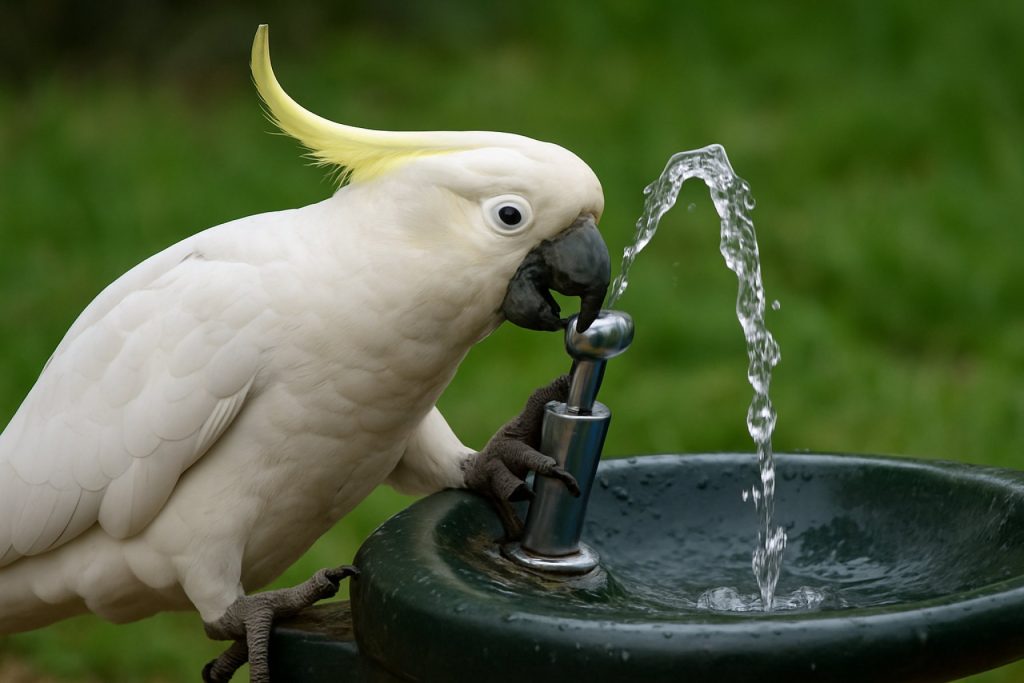
Sydney’s Sulfur-Crested Cockatoos Stun Scientists by Mastering Public Water Fountains—Caught on Camera!
Sydney’s clever cockatoos are making waves online, turning public fountains into urban bird watering holes with their incredible skills.
| Quick Facts |
|---|
| 41% — Success rate as cockatoos operate water fountains in Western Sydney |
| First Time Recorded — Wild parrots using human-made drinking fountains via innovation |
| 100+ — Hours of wildlife camera footage analyzed by researchers |
Move over bin-raiding bandits—Sydney’s sulfur-crested cockatoos have taken their urban mischief to new heights. In an eye-opening new study published in Biology Letters, scientists reveal these bright-white birds have cracked the code to unlocking public drinking fountains across parks and sports fields in Western Sydney.
For years, these iconic Aussie parrots have dazzled city dwellers by prising open wheelie bins to scavenge leftovers. Now, researchers from the Max Planck Institute, University of Vienna, Western Sydney University and Australian National University have caught them on film working their way around new urban puzzles—twist-handle water fountains.
How Did Cockatoos Learn This Astonishing Trick?
The research team placed motion-sensitive cameras throughout Western Sydney’s parks, amassing over 100 hours of footage. What they captured is as amusing as it is remarkable: cockatoos using coordinated footwork—primarily their right foot—to grip and twist fountain handles, while anchoring themselves with the other foot. The bird’s body weight turns the handle against its spring, releasing a gush of cool water. Before long, cockatoos line up on fences at dawn and dusk, waiting politely for their chance at the tap.
Are These Skills Unique to Sydney Cockatoos?
Experts say this level of innovation and tool-use among wild parrots is groundbreaking. Until now, similar problem-solving behaviors in the wild were largely undocumented outside foraging. This “drinking hack” seems to spread quickly within local cockatoo populations, hinting at advanced social learning and possibly the formation of a new urban bird tradition.
Do All Cockatoos Join the Party?
Unlike the earlier bin-opening phenomenon—which was dominated by males—researchers observed both male and female cockatoos embracing the water fountain challenge. The birds displayed individuality in their techniques, but all were driven by the relentless Sydney heat and the lure of a fresh drink.
What Does This Mean for City Wildlife?
These findings confirm that urban wildlife—especially highly intelligent species like cockatoos—are thriving and adapting fast amid the pressures of city life. As habitat loss and extreme weather batter natural environments, Sydney’s feathery residents showcase a knack for seizing urban opportunities.
For researchers, the cockatoo’s new fountain-opening tradition is more than cute—it’s a real-world example of animal problem-solving and cultural innovation, hot topics in behavioral science today.
To explore more about urban birds and animal intelligence, check out resources from National Geographic, BBC, or follow the latest research at the Max Planck Institute.
Q&A: Sydney’s Cleverest Cockatoos
Q: How did the cockatoos pick up the water fountain trick?
A: Observational learning was key—birds watching others succeed quickly copied the handle-turning routine.
Q: When do cockatoos hit the fountains?
A: Mostly at dawn and dusk, avoiding the heat and crowds.
Q: Are other cities seeing similar behavior?
A: So far, this has been spotted mainly in Western Sydney, but experts urge city dwellers to keep their eyes open!
How to Spot Cockatoo Innovation Near You
- Visit local parks or sports ovals around sunrise or sunset.
- Watch for groups of cockatoos near drinking fountains or bins.
- Notice any “line-ups” or coordinated actions—these are signs of learning and adaptation.
- Share your urban wildlife sightings with local ornithologists to contribute to ongoing research.
Catch the action—Sydney’s cockatoos are redefining urban wildlife in 2025. Stay curious, and witness nature’s problem solvers in your neighborhood!
- Watch for innovative wildlife behavior in city parks.
- Document and report animal ingenuity to local researchers.
- Support urban conservation efforts for adaptable species.
- Share footage and sightings on social media to spread awareness.



